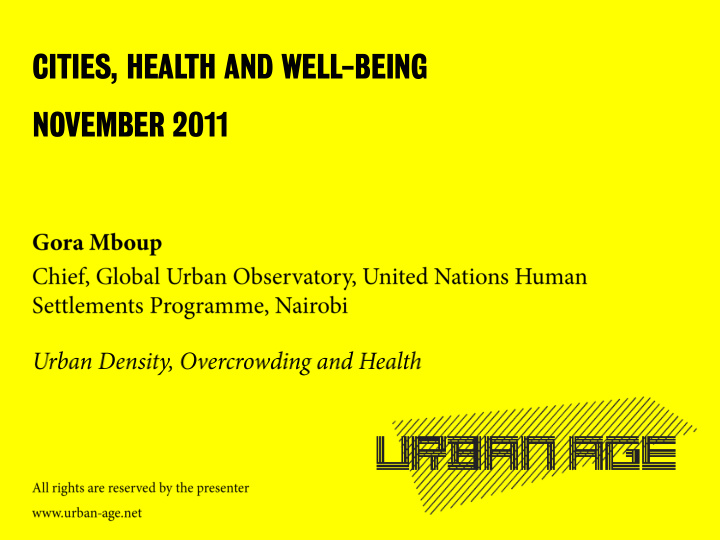



CITIES, HEALTH AND WELL-BEING NOVEMBER 2011
Urban density, overcrowding and health Promoting High density while avoiding overcrowding Urban Age Conference, Hong Kong 16-17 November 2011 Cities, Health and Well-being Gora Mboup, Ph.D. Sr. Demographic and Health Expert Chief, Global Urban Observatory, UN-HABITAT The analysis, conclusions and recommendations of this presentation do not necessarily reflect the views of the United Nations Human Settlements Programme, the Governing Council of the United Nations Human Settlements Programme or its Member States.
Historical view of density and health In the first phase of urbanization, the world experienced high densities, seen as unhealthy, associated with epidemics and crime. However, with the development of medicine, availability of adequate sanitation facilities, water supply, and improvement of living standard in general, cities have become healthier places than rural areas with intra-inequalities.
Measurement and data • Density is associated to people and land: measured here by the number of person square km of land • Crowding is associated to people and housing: measured here by the number of persons per room. Household where more than three people share a room is considered as overcrowded • Findings are based on 7 years of research on housing, overcrowding, water, sanitation, maternal and child health, HIV/AIDS from Demographic and Health Surveys (DHS), Multiple Indicators Cluster Surveys (MICS) and Urban Inequities Surveys (UIS) in over 350 cities of Asia, Africa and LAC.
High density and overcrowding manifest differently Overcrowding has been for long time associated to high population density. However, this study shows that there are cities with high density but low overcrowding rate as there are cities with low density but high overcrowding rate
Overcrowding rates (%) by density (Number of persons/Km2), Africa
Overcrowding rates (%) by density (Number of persons/Km2), LAC
Overcrowding rates (%) by density (Number of persons/Km2), Asia
Potential factors associated with overcrowding for consideration - Urban planning - Housing market - Living conditions - Family size and structure - other social, economic and cultural factors
Overcrowding and health
Complex association between overcrowding and health Overcrowding is one of several environmental factors that can influence health. However, its effect on health has been overstated. It has been associated to many diseases such as: diarrhea, malaria, Acute respiratory infections (ARI), and various other diseases, without disaggregating the conditions on which it may have a negative effect on health. This disaggregation is possible with the shelter deprivation index developed by the Global Urban Observatory of UN-HABITAT in 2004.
The shelter deprivation index Using the four main indicators, water, sanitation, housing and overcrowding, as physical expression of slum, it was possible to measure morbidity differential according to the degree of shelter deprivation: single deprivation or multiple deprivations. The single deprivation includes overcrowding alone while the multiple deprivations include overcrowding in combination with lack of one, two or three among the other shelter variables, housing, water, sanitation
% % Diarrhea among children <5yrs ARI among children <5 yrs 30.0 30.0 25.0 20.0 20.0 15.0 10.0 10.0 5.0 0.0 0.0 Cameroon Uganda Kenya Ethiopia Cameroon Uganda Kenya Ethiopia Urban Have all basic services Overcrowding only Multiple deprivations Lack of basic services such as improved water, improved sanitation, durable housing and sufficient living area expose children to high morbidity
% ARI among children <5 yrs 30.0 % Diarrhea among children <5yrs 30.0 25.0 20.0 20.0 15.0 10.0 10.0 5.0 0.0 0.0 Mozambique Rwanda Egypt Senegal Mozambique Rwanda Egypt Senegal Urban Have all basic services Overcrowding only Multiple deprivations Lack of basic services such as improved water, improved sanitation, durable housing and sufficient living area expose children to high morbidity
% % Diarrhea among children <5yrs ARI among children <5yrs 30.0 30.0 20.0 20.0 10.0 10.0 0.0 0.0 Mozabique Senegal Egypt Mozabique Senegal Egypt Capital City Small cities/town Rural Capital City Small cities/town Rural
Living in environmental led diseases expose children to high morbidity • Lack of improved water • Lack of adequate sanitation • Poor housing conditions • Overcrowding All put together are characteristics of slum that expose children to high morbidity.
In 2010, six out ten people in Sub-Saharan Africa live in slums When rapid urban growth does not come with basic urban infrastructure, slums expand and the urban divide widens. The lack of basic services is to be attributed largely to various factors, among them inadequate urban planning leaving cities at risk of becoming more deeply mired in pollution, disease and social ills.
In absence of adequate urban planning and housing policy, African cities expand with large inequalities of access to basic services Addis Ababa, UIS 2004
Unplanned urban growth leading to sprawl and overcrowding and lack of other basic services Addis ababa,2000
Unplanned urban growth leading to sprawl and overcrowding and lack of other basic services Addis Ababa, 2004
How to take advantage of high densities? Promoting high densities while avoiding overcrowding • Adequate urban planning: socially integrated, connected and compacted cities • When promoting high density, land and housing shall be factored as associated variables • Accessibility to basic services (water, sanitation, health services) taken into account This determines the extent to which a city takes advantage of being centre of concentrated production and population, and avoids the negative externalities.
Elements of urban planning that support high densities while avoiding overcrowding -Mixed use of land - Design of public spaces - Prioritize streets as basic elements for mobility, accessibility, service delivery, etc. - Enhance economic value of land and encourage investments - Reduce risks from natural hazards and increase resilience - Minimize the costs of infrastructure maintenance - ……………
Recommend
More recommend